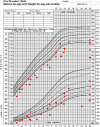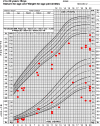The phenotype of Floating-Harbor syndrome: clinical characterization of 52 individuals with mutations in exon 34 of SRCAP
- PMID: 23621943
- PMCID: PMC3659005
- DOI: 10.1186/1750-1172-8-63
The phenotype of Floating-Harbor syndrome: clinical characterization of 52 individuals with mutations in exon 34 of SRCAP
Abstract
Background: Floating-Harbor syndrome (FHS) is a rare condition characterized by short stature, delays in expressive language, and a distinctive facial appearance. Recently, heterozygous truncating mutations in SRCAP were determined to be disease-causing. With the availability of a DNA based confirmatory test, we set forth to define the clinical features of this syndrome.
Methods and results: Clinical information on fifty-two individuals with SRCAP mutations was collected using standardized questionnaires. Twenty-four males and twenty-eight females were studied with ages ranging from 2 to 52 years. The facial phenotype and expressive language impairments were defining features within the group. Height measurements were typically between minus two and minus four standard deviations, with occipitofrontal circumferences usually within the average range. Thirty-three of the subjects (63%) had at least one major anomaly requiring medical intervention. We did not observe any specific phenotype-genotype correlations.
Conclusions: This large cohort of individuals with molecularly confirmed FHS has allowed us to better delineate the clinical features of this rare but classic genetic syndrome, thereby facilitating the development of management protocols.
Figures










Similar articles
-
[Floating-Harbor syndrome: a case report and literature review].Zhongguo Dang Dai Er Ke Za Zhi. 2019 Dec;21(12):1208-1211. doi: 10.7499/j.issn.1008-8830.2019.12.011. Zhongguo Dang Dai Er Ke Za Zhi. 2019. PMID: 31874661 Free PMC article. Review. Chinese.
-
Not all floating-harbor syndrome cases are due to mutations in exon 34 of SRCAP.Hum Mutat. 2013 Jan;34(1):88-92. doi: 10.1002/humu.22216. Epub 2012 Oct 16. Hum Mutat. 2013. PMID: 22965468
-
Mutations in SRCAP, encoding SNF2-related CREBBP activator protein, cause Floating-Harbor syndrome.Am J Hum Genet. 2012 Feb 10;90(2):308-13. doi: 10.1016/j.ajhg.2011.12.001. Epub 2012 Jan 19. Am J Hum Genet. 2012. PMID: 22265015 Free PMC article.
-
Expanded spectrum of exon 33 and 34 mutations in SRCAP and follow-up in patients with Floating-Harbor syndrome.BMC Med Genet. 2014 Nov 30;15:127. doi: 10.1186/s12881-014-0127-0. BMC Med Genet. 2014. PMID: 25433523 Free PMC article.
-
When chromatin organisation floats astray: the Srcap gene and Floating-Harbor syndrome.J Med Genet. 2016 Dec;53(12):793-797. doi: 10.1136/jmedgenet-2016-103842. Epub 2016 Apr 26. J Med Genet. 2016. PMID: 27208210 Review.
Cited by
-
Effects of long-term growth hormone therapy in a girl with Floating-Harbor syndrome.Ann Pediatr Endocrinol Metab. 2020 Jun;25(2):126-131. doi: 10.6065/apem.1938144.072. Epub 2020 Jun 30. Ann Pediatr Endocrinol Metab. 2020. PMID: 32615693 Free PMC article.
-
Single Amino Acid Change Underlies Distinct Roles of H2A.Z Subtypes in Human Syndrome.Cell. 2019 Sep 5;178(6):1421-1436.e24. doi: 10.1016/j.cell.2019.08.002. Cell. 2019. PMID: 31491386 Free PMC article.
-
[Floating-Harbor syndrome: a case report and literature review].Zhongguo Dang Dai Er Ke Za Zhi. 2019 Dec;21(12):1208-1211. doi: 10.7499/j.issn.1008-8830.2019.12.011. Zhongguo Dang Dai Er Ke Za Zhi. 2019. PMID: 31874661 Free PMC article. Review. Chinese.
-
Whole exome sequencing to identify genetic causes of short stature.Horm Res Paediatr. 2014;82(1):44-52. doi: 10.1159/000360857. Epub 2014 Jun 20. Horm Res Paediatr. 2014. PMID: 24970356 Free PMC article. Clinical Trial.
-
Combined exome and whole transcriptome sequencing identifies a de novo intronic SRCAP variant causing DEHMBA syndrome with severe sleep disorder.J Hum Genet. 2024 Jun;69(6):287-290. doi: 10.1038/s10038-024-01240-x. Epub 2024 Mar 7. J Hum Genet. 2024. PMID: 38448605
References
-
- Pelletier G, Feingold M. Case report 1. Syndrome Identification. 1973;1:8–9.
-
- Leisti J, Hollister DW, Rimoin DL. The Floating-Harbor syndrome. Birth Defects Orig Artic Ser. 1975;11:305. - PubMed
-
- Hood RL, Lines MA, Nikkel SM, Schwartzentruber J, Beaulieu C, Nowaczyk MJ, Allanson J, Kim CA, Wieczorek D, Moilanen JS, Lacombe D, Gillessen-Kaesbach G, Whiteford ML, Quaio CR, Gomy I, Bertola DR, Albrecht B, Platzer K, McGillivray G, Zou R, McLeod DR, Chudley AE, Chodirker BN, Marcadier J, Canada Consortium FORGE, Majewski J, Bulman DE, White SM, Boycott KM. Mutations in SRCAP, encoding SNF2-related CREBBP activator protein, cause Floating-Harbor syndrome. Am J Hum Genet. 2012;90:308–313. doi: 10.1016/j.ajhg.2011.12.001. - DOI - PMC - PubMed
Publication types
MeSH terms
Substances
Supplementary concepts
Grants and funding
LinkOut - more resources
Full Text Sources
Other Literature Sources
Medical

